Explore the world of herbal tea blending with these engaging workshop activities. Set up a sensory exploration station to examine herbs visually, tactilely, and aromatically. Challenge participants with a blind taste test to identify flavors and ingredients. Play an aroma matching game to hone scent recognition skills. Host a custom blend creation competition for unique tea combinations. Pair seasonal ingredients for themed blends. Organize a herbal benefits scavenger hunt to discover medicinal properties. Map flavor profiles to understand taste interactions. Develop tea-infused recipes for culinary creativity. Create personalized blend names to capture each tea's essence. These activities will steep you in the art of herbal tea crafting.
Sensory Exploration Station
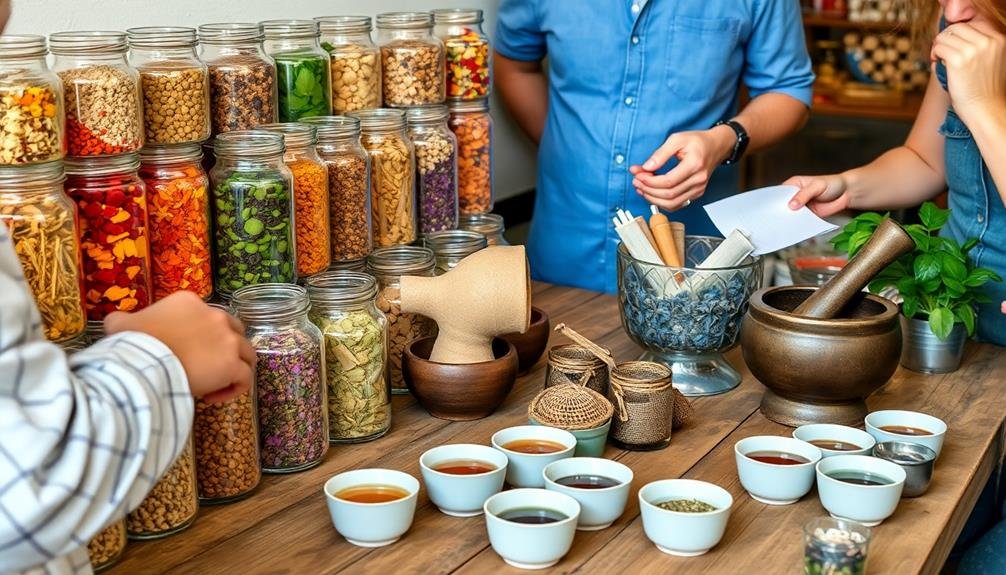
A sensory exploration station forms the foundation of any herbal tea blending workshop. You'll want to set up an area where participants can engage with various herbs using all their senses.
Start by displaying a wide array of dried herbs in clear containers, allowing attendees to visually examine the colors, textures, and shapes. Encourage participants to touch and feel the herbs, noting differences in texture between leaves, flowers, and roots.
Next, invite them to smell each herb, paying attention to the intensity and nuances of the aromas. Provide small samples for tasting, but remind everyone to use caution with unfamiliar plants.
To enhance the experience, include informational cards for each herb, detailing its properties, traditional uses, and flavor profile. You can also incorporate a sound element by including recordings of nature sounds associated with herb cultivation or tea preparation.
As participants explore, prompt them to take notes on their observations and preferences. This sensory exploration will help them develop a deeper understanding of individual herbs and guide their blending choices later in the workshop.
Blind Taste Test Challenge
Building on the sensory exploration, the Blind Taste Test Challenge adds an element of excitement and discovery to your herbal tea blending workshop. In this activity, you'll prepare several unmarked herbal tea samples for participants to taste blindfolded. As they sip each tea, encourage them to focus on identifying individual flavors, aromas, and mouthfeel sensations.
Provide tasting sheets where participants can jot down their observations and guesses about the ingredients. After tasting all samples, reveal the contents of each blend and discuss the results. This exercise sharpens participants' palates and helps them recognize subtle flavor nuances.
To make it more engaging, you can turn it into a friendly competition. Award points for correctly identified ingredients and offer a prize for the most accurate taster. You can also include some surprising blends or unusual herbs to challenge even experienced tea drinkers.
The Blind Taste Test Challenge not only improves participants' tasting skills but also inspires creativity in their own blending efforts. It encourages them to think beyond conventional flavor combinations and explore new possibilities in herbal tea creation.
Aroma Matching Game
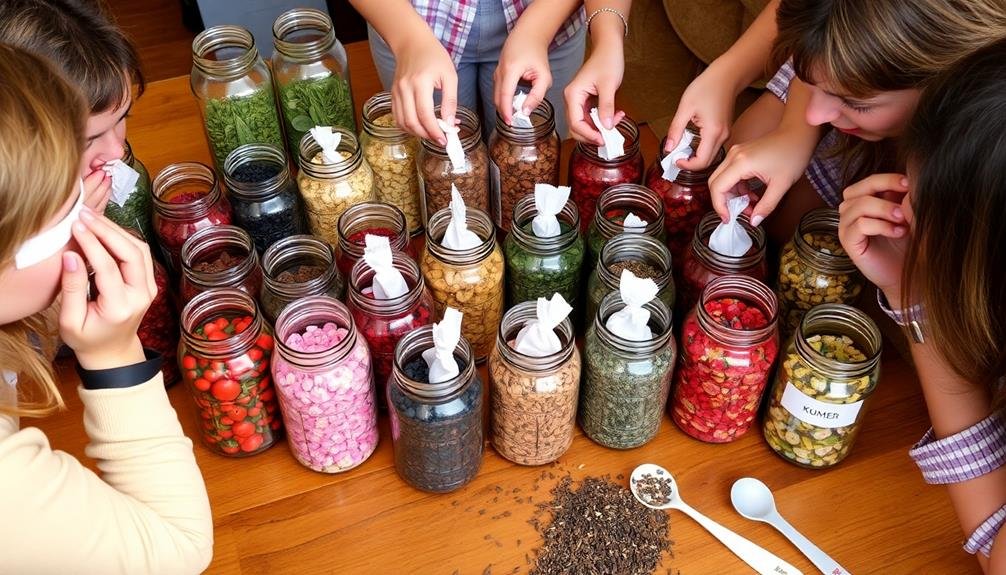
Many herbal tea enthusiasts find that aroma plays a crucial role in their enjoyment of tea. To hone your olfactory skills and deepen your appreciation for herbal teas, try incorporating an aroma matching game into your workshop.
Set up several stations with covered containers holding different dried herbs and tea blends. Provide participants with scent strips and a list of the herbs present. Ask them to sniff each container and match the aroma to the corresponding herb on the list. This exercise will help them identify individual scents within complex blends.
To increase difficulty, include some similar-smelling herbs like chamomile and chrysanthemum or peppermint and spearmint. You can also add a twist by including a few mystery scents not on the list, challenging participants to describe the aroma in their own words.
As they progress through the stations, encourage participants to take notes on the characteristics of each scent. Discuss how different aromas might complement or clash with one another in a blend.
This activity will sharpen their sensory skills and inspire creative combinations in their own tea blending experiments.
Custom Blend Creation Competition
To cap off your herbal tea blending workshop, organize a custom blend creation competition. This activity will challenge participants to apply their newfound knowledge and creativity. Divide attendees into small groups or have them work individually, depending on the size of your workshop.
Provide each competitor with a selection of dried herbs, flowers, and spices. Include both common and unique ingredients to encourage experimentation. Set a time limit, typically 20-30 minutes, for participants to create their signature blend. Encourage them to reflect on flavor profiles, health benefits, and visual appeal.
Once the blends are complete, have participants present their creations to the group. Organize a tasting session where everyone can sample each blend. To determine the winner, use a voting system based on the following criteria:
- Taste and aroma
- Creativity and originality
- Presentation and visual appeal
Award prizes to the top three blends, such as tea accessories or rare ingredients.
This competition not only reinforces learning but also fosters a sense of accomplishment and camaraderie among participants. It's an excellent way to conclude your workshop on a high note, leaving everyone inspired to continue exploring the art of herbal tea blending.
Seasonal Ingredient Pairing Exercise
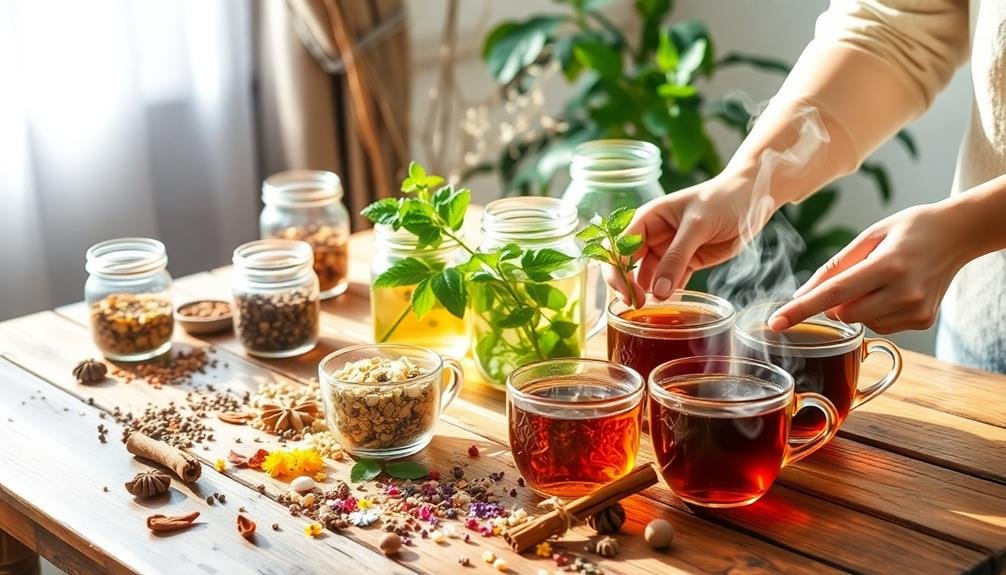
Seasonal ingredients can elevate your herbal tea blends, and this exercise will help you master the art of pairing them effectively. Begin by dividing participants into groups and assigning each a specific season. Provide a selection of seasonal herbs, flowers, and fruits for each group to work with.
Challenge your groups to create three unique blends that capture the essence of their assigned season. Encourage them to contemplate flavor profiles, aroma, and visual appeal. As they experiment, have them document their combinations and tasting notes.
| Season | Ingredients | Flavor Profile |
|---|---|---|
| Spring | Lavender, Mint, Lemon Balm | Fresh, Floral |
| Summer | Hibiscus, Lemongrass, Peach | Fruity, Tangy |
| Autumn | Cinnamon, Apple, Ginger | Warm, Spicy |
After blending, organize a tasting session where groups present their creations. Discuss how each blend represents its season and what makes it successful. Encourage participants to share their insights on ingredient compatibility and seasonal characteristics. This exercise will enhance your understanding of how different flavors work together and how to craft teas that reflect the changing seasons, ultimately improving your blending skills.
Tea and Food Pairing
Exploring the art of tea and food pairing can elevate your herbal tea experience to new heights. In this workshop activity, you'll learn to match different herbal tea blends with complementary foods, enhancing both flavors.
Start by brewing a variety of herbal teas, such as chamomile, peppermint, and rooibos. Then, gather an assortment of foods, including cheeses, fruits, chocolates, and savory snacks.
To guide your pairing adventure, consider these principles:
- Contrast flavors: Pair light, delicate teas with rich, creamy foods to create a balanced taste experience.
- Match intensities: Bold, full-bodied teas work well with strongly flavored foods, while subtle teas complement milder dishes.
- Explore complementary notes: Look for shared flavor profiles between the tea and food, such as floral, fruity, or earthy undertones.
As you experiment with different combinations, take notes on what works best.
You'll discover unexpected pairings that delight your palate and expand your culinary horizons. This activity not only enhances your tea-drinking experience but also provides valuable insights for creating custom blends that pair perfectly with your favorite foods.
Herbal Benefits Scavenger Hunt
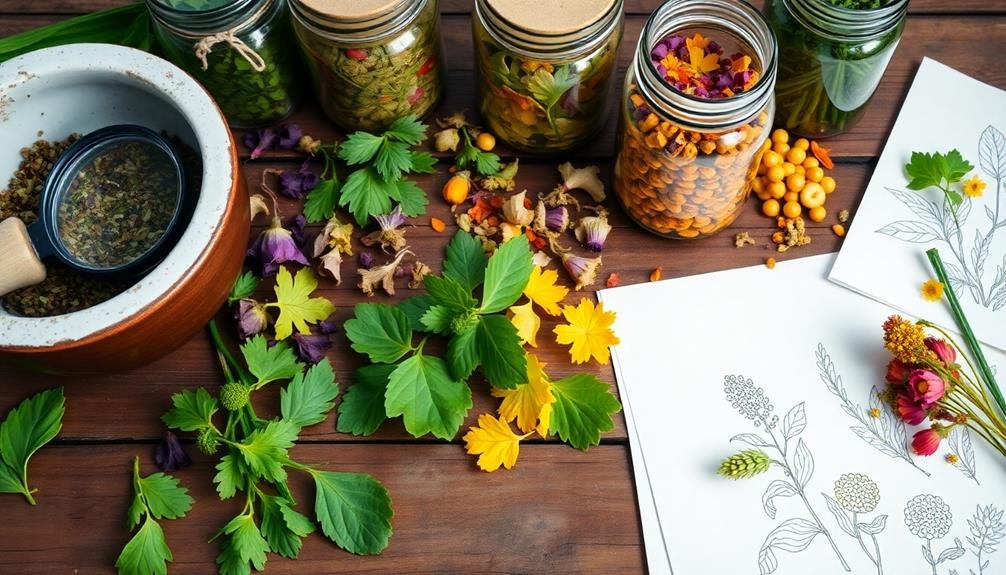
A treasure trove of herbal knowledge awaits participants in this engaging scavenger hunt activity.
You'll divide your group into teams and provide each with a list of herbal benefits to find. Scatter various herbs, tea samples, and informational cards around the workshop space. Teams must locate and identify herbs that match the listed benefits.
As you search, you'll discover chamomile's calming properties, peppermint's digestive aid, and echinacea's immune-boosting power. You might find ginger for nausea relief or lavender for better sleep. Each team must collect evidence of their findings, such as herb samples or photos.
To add complexity, include some lesser-known herbs like ashwagandha for stress relief or holy basil for cognitive function. Encourage teams to use provided resources like herb guides or mobile apps for research. Set a time limit to keep the hunt exciting and competitive.
Once time's up, gather everyone to share discoveries. Each team presents their findings, explaining the herbs' benefits and potential uses in tea blends.
This activity not only educates but also sparks creativity for future tea blending experiments.
Flavor Profile Mapping
Now that you've learned about various herbs and their benefits, it's time to map out their flavor profiles. This activity will help you understand how different herbs interact and complement each other in a blend.
You'll create a visual representation of each herb's taste characteristics, making it easier to craft balanced and flavorful teas.
To begin, gather a selection of dried herbs and prepare small samples of each as a tea. As you taste each infusion, consider its primary flavor notes and intensity.
Use a large sheet of paper or a whiteboard to create your flavor map. Place sweeter herbs towards one side and more bitter ones on the opposite end. Arrange herbs with similar flavor profiles close together.
Next, explore how different herbs combine by following these steps:
- Choose two herbs with contrasting flavors
- Brew a small amount of each separately
- Mix the two infusions in different ratios, noting how the flavors interact
Tea-Infused Recipe Development
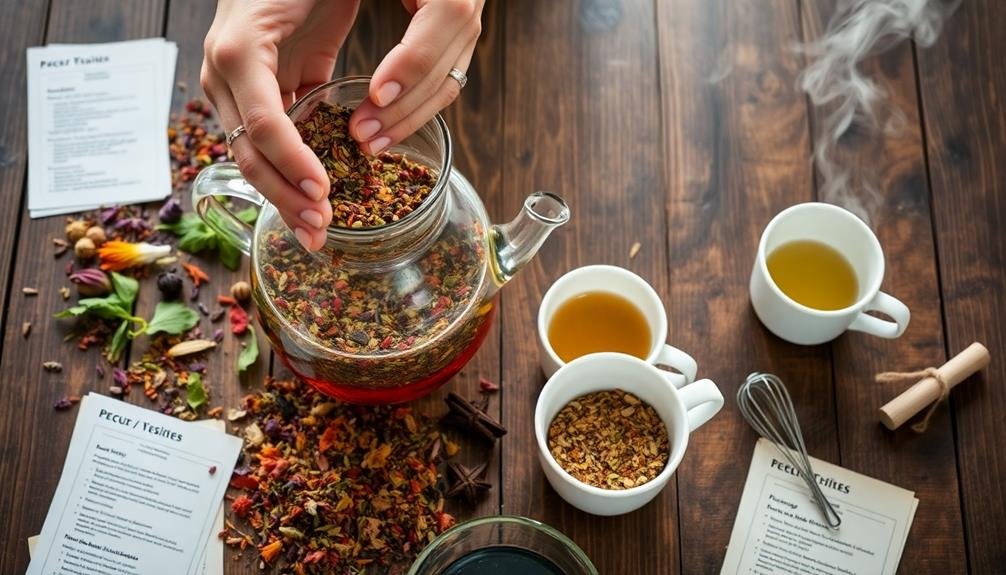
Ready to take your herbal tea blending skills to the next level? Tea-infused recipe development is an exciting way to explore the culinary potential of your custom blends.
Start by brainstorming dishes that could benefit from a tea-infused twist. Consider sweet and savory options, from baked goods to marinades and sauces.
Choose a tea blend that complements your recipe's flavors. For desserts, try chamomile or lavender infusions in custards or cakes. Experiment with green tea in savory dishes like stir-fries or broths. Earl Grey can add depth to chocolate treats, while rooibos pairs well with fruity compotes.
To infuse your recipes, steep the tea in hot liquid (water, milk, or oil) that's part of your dish. Adjust steeping time and tea quantity to achieve desired intensity. Alternatively, grind dried tea leaves into a fine powder and incorporate them directly into your recipe.
Don't forget about beverages! Create unique cocktails or mocktails using your herbal blends as a base or flavoring agent. Try iced tea variations, tea-infused lemonades, or even tea-based smoothies.
Remember to document your experiments and refine your recipes for future use.
Personalized Tea Blend Naming
With your custom tea blend perfected, it's time to give it a memorable name. This creative process allows you to capture the essence of your unique creation and make it stand out. Consider the ingredients, flavors, and intended effects when brainstorming names. You might draw inspiration from the tea's dominant notes, its purpose (such as relaxation or energy), or even the emotions it evokes.
To help you craft the perfect name for your personalized tea blend, try these techniques:
- Word association: Write down words related to your tea's ingredients, flavors, and effects. Combine or play with these words to create catchy phrases.
- Storytelling: Think about the journey or experience your tea represents. Use elements from this narrative to form an evocative name.
- Sensory language: Incorporate words that appeal to the senses, describing the tea's aroma, taste, or visual appearance.
Don't be afraid to get creative with puns, alliteration, or rhymes. Remember, the name should be easy to remember and pronounce.
Once you've settled on a name, create a simple label or tag to complete your personalized tea blend experience.
Frequently Asked Questions
How Long Does a Typical Herbal Tea Blending Workshop Last?
You'll typically spend 2-3 hours in a herbal tea blending workshop. It's enough time to learn about different herbs, experiment with blends, and create your own unique tea mixtures. Don't worry, you'll be sipping samples too!
Are There Any Age Restrictions for Participating in the Workshop?
You'll find most workshops welcome adults of all ages. There's usually no upper age limit. Some may have a minimum age requirement, often 16 or 18. It's best to check with the specific workshop organizer for their policy.
Do Participants Need to Bring Their Own Equipment or Ingredients?
You don't need to bring anything! We'll provide all necessary equipment and ingredients for the workshop. Just come with an open mind and a willingness to explore new flavors. You're welcome to bring a notebook if desired.
Is There a Maximum Number of Attendees Allowed per Workshop Session?
Yes, there's typically a maximum number of attendees per session. You'll find this limit varies depending on the venue size and instructor's preference. It's best to check with the organizer for specific details about attendance caps.
Are There Any Certifications or Qualifications Offered Upon Completion of the Workshop?
You won't receive official certifications or qualifications after completing the workshop. However, you'll gain valuable hands-on experience and knowledge about herbal tea blending. You'll also get a certificate of participation to commemorate your achievement.
In Summary
You've now explored a world of herbal tea blending possibilities. From sensory adventures to creative competitions, you've engaged all your senses and expanded your knowledge. As you continue experimenting with flavors and ingredients, don't forget to trust your instincts and have fun. Whether you're blending for health benefits or pure enjoyment, you're well-equipped to create unique, personalized tea blends that'll delight your taste buds and nourish your body.

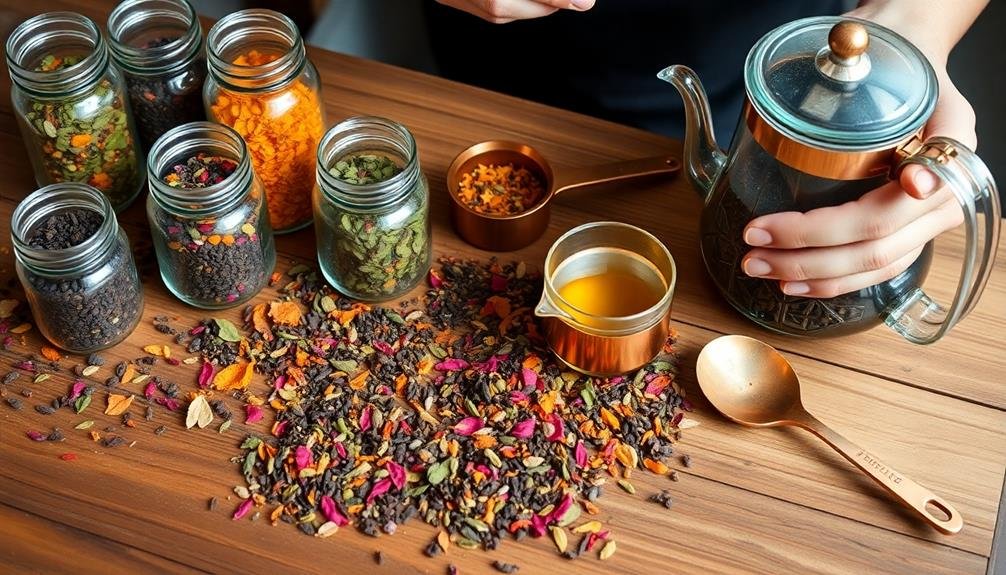
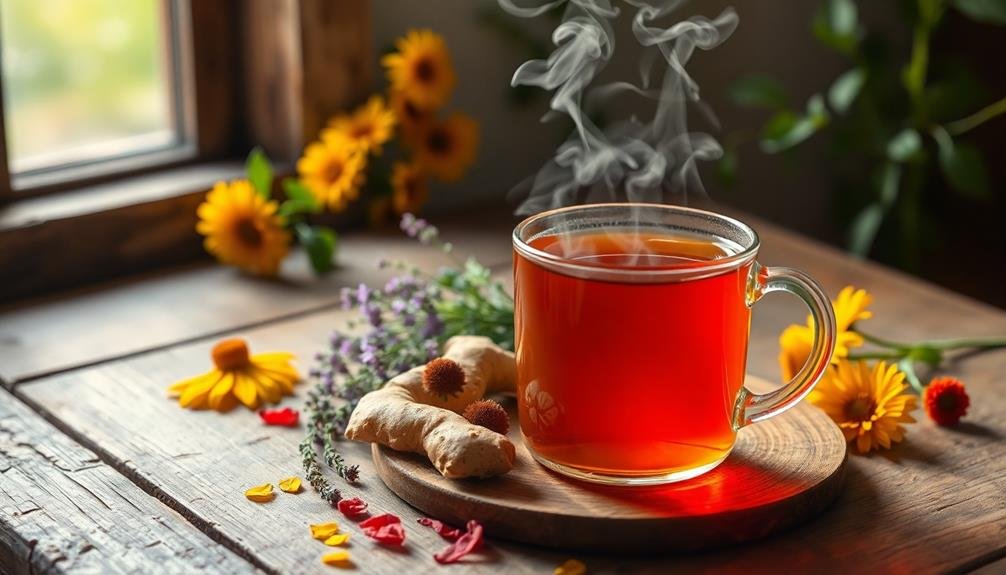
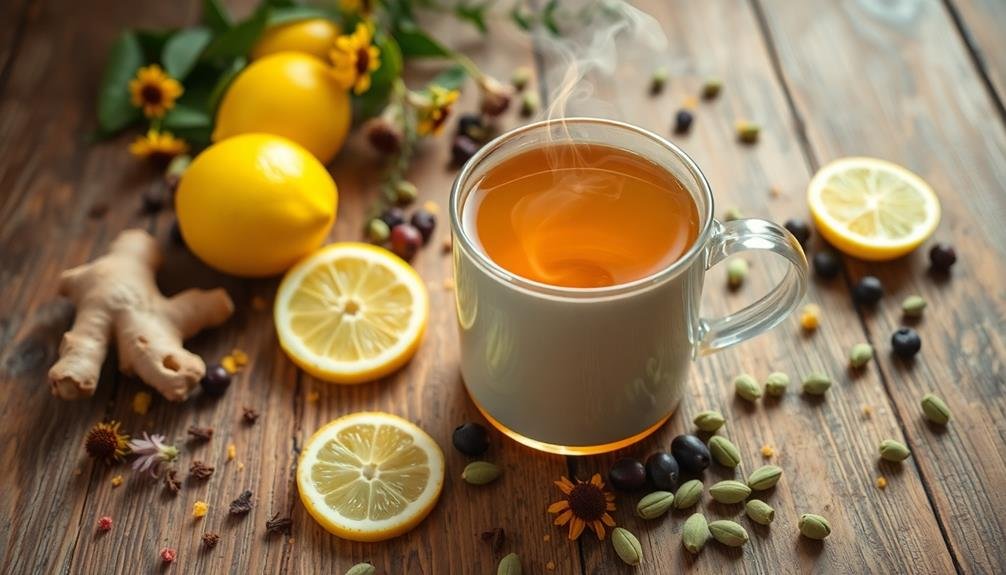
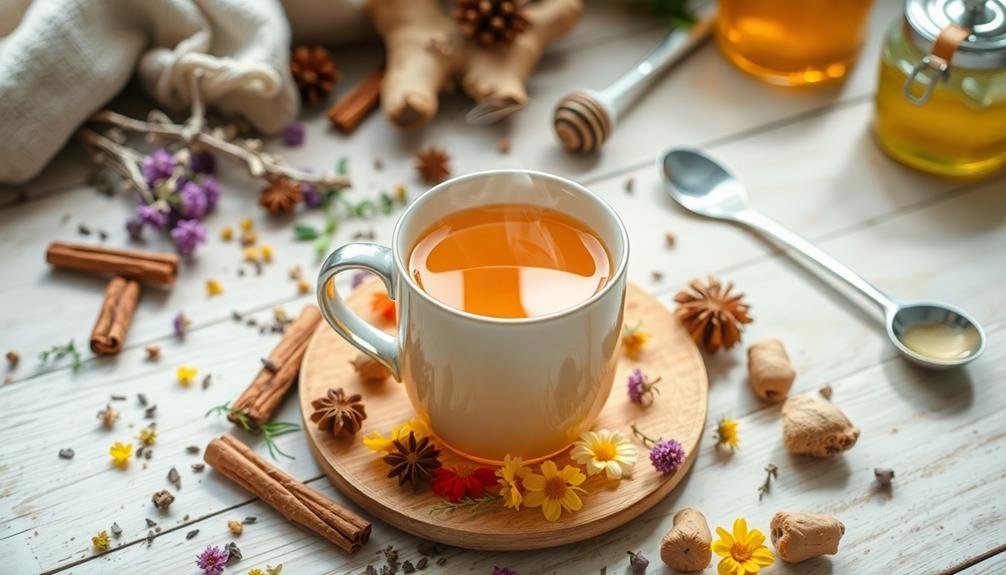
Leave a Reply